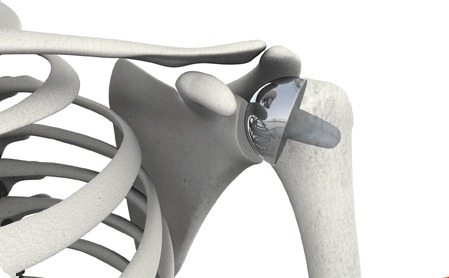
There are some cases like severe arthritis or fracture of upper arm bone with tissue death, in such cases Total Shoulder Replacement is recommended. Total Shoulder Replacement involves removal of the complete humeral head and insertion of a prosthesis in its place. Total shoulder replacement is considered the most reliable surgical option for relieving debilitating shoulder arthritis, but it is not appropriate for people who want to remain very active or have damaged rotator cuff muscles.
However, there are some cases where full replacement of the shoulder is not necessary. In certain cases of trauma, where part of the shoulder is broken, it may only be necessary to replace part of the humeral head. In such cases, Shoulder Resurfacing is recommended. It is ideal for those young patients who have active lifestyle and does not want to go through the concerns of durability of the implants used.Postponing shoulder surgery is never advisable as this can cause muscle atrophy from lack of use, making post-surgical rehabilitation more challenging and also lead to excessive glenoid bone loss, complicating the surgeon’s ability to resurface the socket side of the joint. So when a Total Shoulder Replacement is not preferred then Shoulder Resurfacing is the best bet.
Apart from Arthroplasty the other types of Shoulder Resurfacing surgeries are;
- Ream-and-run – The head of the upper arm bone is replaced with a metal ball. The person’s natural socket (glenoid) is reshaped to match the curvature of the metal ball.This process is also called a hemiarthroplasty with non-prosthetic glenoid arthroplasty.
- Hemiarthroplasty – Similar to a ream-and-run in that the head of the upper arm bone is replaced with a metal ball. However, in hemiarthroplasty, the person’s natural socket is not reshaped to match the curvature of the ball.
In Shoulder Resurfacing, part of the humeral head is preserved. The remaining damaged part is replaced with a hemispheric metallic head. This gives a new surface to the damaged part of the humeral bone, allowing most of the natural bone to remain intact. Shoulder resurfacing involves “smoothing out” the spot where the upper arm bone (humerus) and shoulder blade (scapula) meet (the glenohumeral joint). The “ball” of the upper arm bone is replaced by a prosthesis, but the patient’s natural shoulder blade bone is left in place. A shoulder resurfacing surgeon may also use specialized surgical instruments to remove abnormal tissue from the spot on the shoulder blade that makes contact with the upper arm (glenoid).
The Shoulder Resurfacing procedure is performed under general or local anesthesia and usually takes about 2 hours to complete. An incision is made in the front of your shoulder.Shoulder Resurfacing is off late used as an alternative to Total Shoulder Replacement, for patients who are young and have active lifestyles. It preserves rather than removes, the humeral head. It is also a less invasive option and provides faster recovery. There is less blood loss and less pain. Less hospital stay post-surgery and rehabilitation begins the same day. Another advantage is, as limited amount of implanted material is used, infections, if it occurs can be dealt with more easily.Shoulder resurfacing is also used to treat a condition called avascular necrosis. In avascular necrosis, blood does not flow properly to the upper arm bone, causing bone tissue to die.
Patients with Shoulder Resurfacing usually stay in the hospital only for a day or two. Mild Physiotherapy begins the same day of surgery or the next day. Doctors advise to wear a sling generally for 6 weeks. High-contact sports are generally not allowed after Shoulder Resurfacing surgery because it could lead to complications.Resurfacing can be used in patients with mild to moderate arthritis that is confined to the humeral head. The ideal candidate for Shoulder Resurfacing Surgery must be healthy and have sufficient bone matter to undergo the procedure successfully. The patient should not be suffering from high blood pressure or diabetes. If the patient is suffering from rheumatoid arthritis, then the medical management team will include a skilled rheumatologist.
Shoulder Resurfacing has been developed in the last 25 years. The first Total Shoulder Resurfacing procedure was performed in 1958 by Dr Charles O Townley with a metal humeral component and a polyurethane glenoid. Subsequent shoulder resurfacing procedures were performed using small hip resurfacing prostheses. Shoulder resurfacing has gained favor by surgeons and patients for several reasons. The primary reason is that the humeral head is retained, as opposed to total shoulder arthroplasty, which removes the entire humeral head. Shoulder resurfacing offers more bone retention, and if future revision surgery is necessary, the surgery is less involved making the recuperation much faster for the patient. Shoulder resurfacing surgery is generally more effective than total joint replacement. Owing to minimal bone resection, absence of osteotomy, and low incidence of periprosthetic fracture, this type of surgery is considered to be more effective for those whose shoulder joint problems are in the initial stages.
For enquiries related to Total Shoulder Resurfacing procedure, write to www.BangaloreShoulderInstitute.com or call 9846789204
